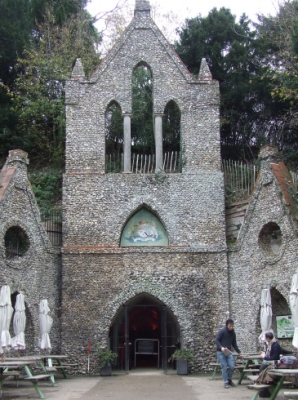Mar 29 2014
A PhD student at the University of Bristol is raising money to undertake a ground-breaking 3D scan of one of the most mysterious sites in the UK - the Hell-Fire Caves of West Wycombe.
 Hell-Fire Caves
Hell-Fire Caves
Aisling Tierney, who is self-funding her PhD, is researching the historical archaeology of Hell-Fire Clubs across the UK and Ireland.
Hell-Fire Clubs began in London in the 1720s and spread from there to Dublin and Limerick. Each club was very different, but they were usually headed up by landed gentry and saw heavy drinking and countryside retreats – as well as attracting accusations of blasphemy.
The Hell-Fire Caves of West Wycombe stretch for a quarter of a mile underground. The man-made caves were hewn from a hill near West Wycombe, and include corridors and banqueting halls.
They were built under the direction of Sir Francis Dashwood, who was a wealthy aristocrat with huge political power. His interests included drinking, literature and blasphemy, and the caves were built to reflect these.
The Hell-Fire Caves have never been studied before and all analysis of the Hell-Fire Clubs has been by lay historians reliant on documentary evidence, with a lack of archaeological and theoretical analysis.
Aisling’s research focuses on an approach covering material culture, archaeology, history and archaeological theoretical insights.
3D imaging will provide a more interactive map, as well as allowing for in-depth analysis, such as the number of man-hours required to carve the caves, carved symbols, tunnels and the relative size and spacing of the chambers.
Aisling said: “In 2008, I went to the Oxfam second-hand bookshop on Park Street, Bristol, and came across a book by Geoffrey Ashe – The Hell-Fire Clubs: A History of Immorality. It was fascinating, but one thing struck me; while the historical content was fairly good, there was simply no acknowledgement of the archaeology. The author hadn’t even thought to check out the physical building remains of the Hell-Fire Clubs, he had just assessed documentary evidence.
“The archaeologist in me was screaming to look at the sites and see how they might impact on our understanding of what the clubs were really about. That’s when I started investigating and found out that there were intact buildings in my home county of Limerick, Ireland, further west in Dublin, and in Buckinghamshire.”
As well as the results providing an essential part of Aisling’s PhD research, other organisations have also expressed an interest, such as the British Geographical Survey group who could use it as a test bed for surveying techniques.
Further uses for the scans could include tourism, including a virtual walkthrough for those unable to physically access them.
Aisling is currently appealing for funding through a WeFund Appeal, and hopes to conduct the scanning between April and June 2014.
You can also follow her progress via her Twitter account.